
Natalie Keyssar: “You Push Yourself to the Edge of the Most Intense Things”
You worked on many projects about violence and protests, but you’ve never documented a full-scale war before. What brought you to Ukraine?
It’s such a mix of so many things. My great-grandparents are from Odesa and the Khmelnytskyi region, so three-quarters of my family is from Ukraine. I was always very interested in Ukraine and dreamt about going there. During the Maydan Revolution, I was still such a young photographer and was not ready to go. And when the full-scale invasion began, I got so angry and heartbroken, that I felt the urge to do something. I had a friend going to Ukraine, and I asked him if I could join him. Unexpectedly, he said “yes”. So, basically, I went to the border with no real plan.
Were you scared to go to a country that was at full-scale war? Did any of your fears and concerns come true?
I was super scared, and because of that fear, I’ve moved slowly throughout this year. I first went to Poland, then to Lviv, and then to Kyiv. I was trying to learn about risks enough. Understanding risks means working responsibly. I never wanted to do something reckless and burden Ukrainian paramedics with saving my life.
I have enough experience covering ground-level violence, crazy crowds, and men with guns. I know how I should behave in those situations. But this was a whole other level. I remember arriving in Lviv and understanding that everybody was afraid of the sky. Russians have made the Ukrainian people afraid of the sky, how evil that is!
I have enough experience covering ground-level violence, crazy crowds, and men with guns. I know how I should behave in those situations. But this was a whole other level.
I’ve seen the worst things that I could have possibly imagined this year. And I’ve also come to understand that even in extreme situations you find a way to carry on, you adapt, get your work done, get used to it. And not that anybody should have to adjust to these things, but in some way, all situations become workable when there is no other choice.
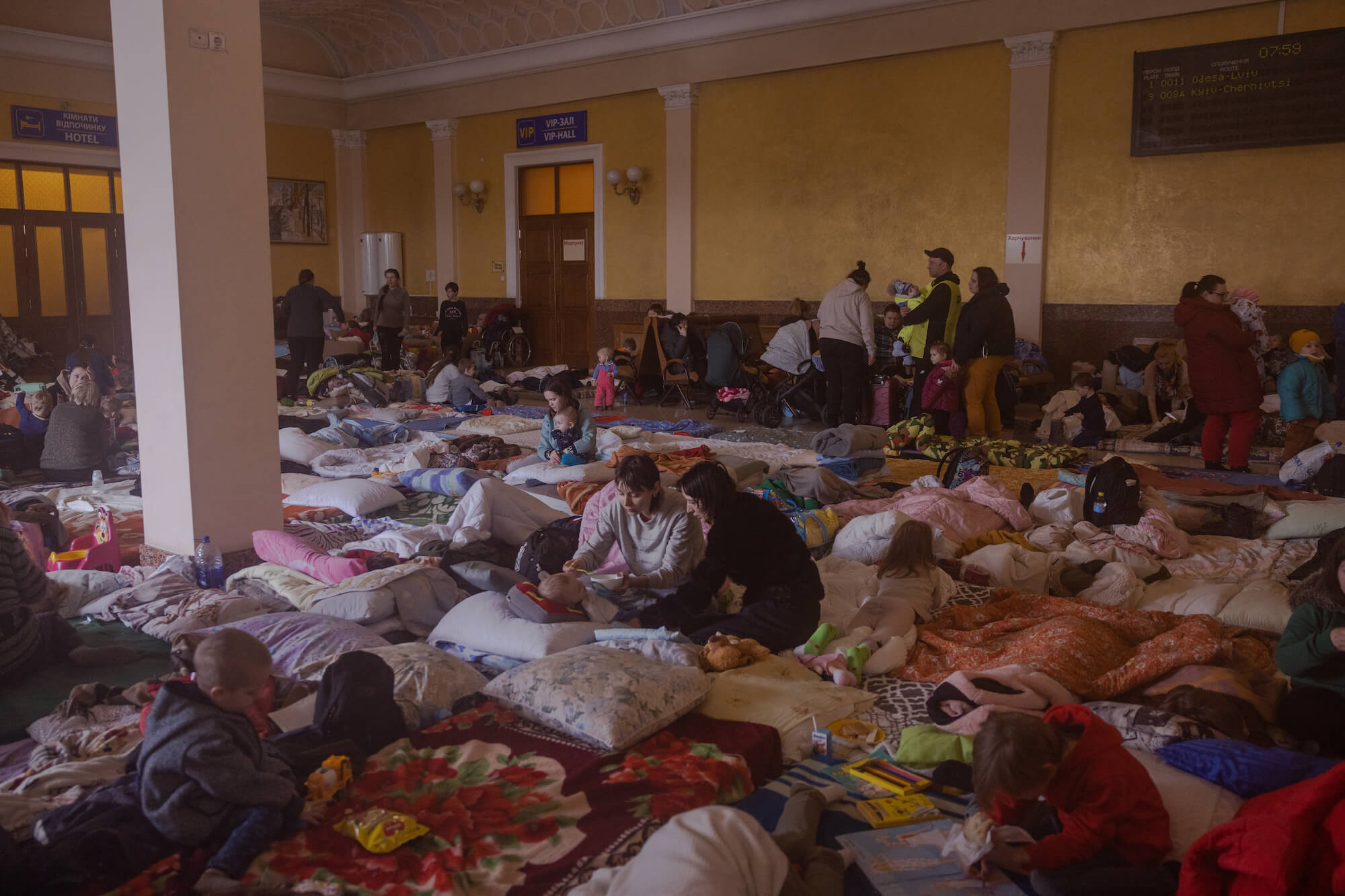
Shelter organized at the Lviv railway station. March 2022

Children play in a bomb shelter in Kyiv while it was encircled by Russian forces.
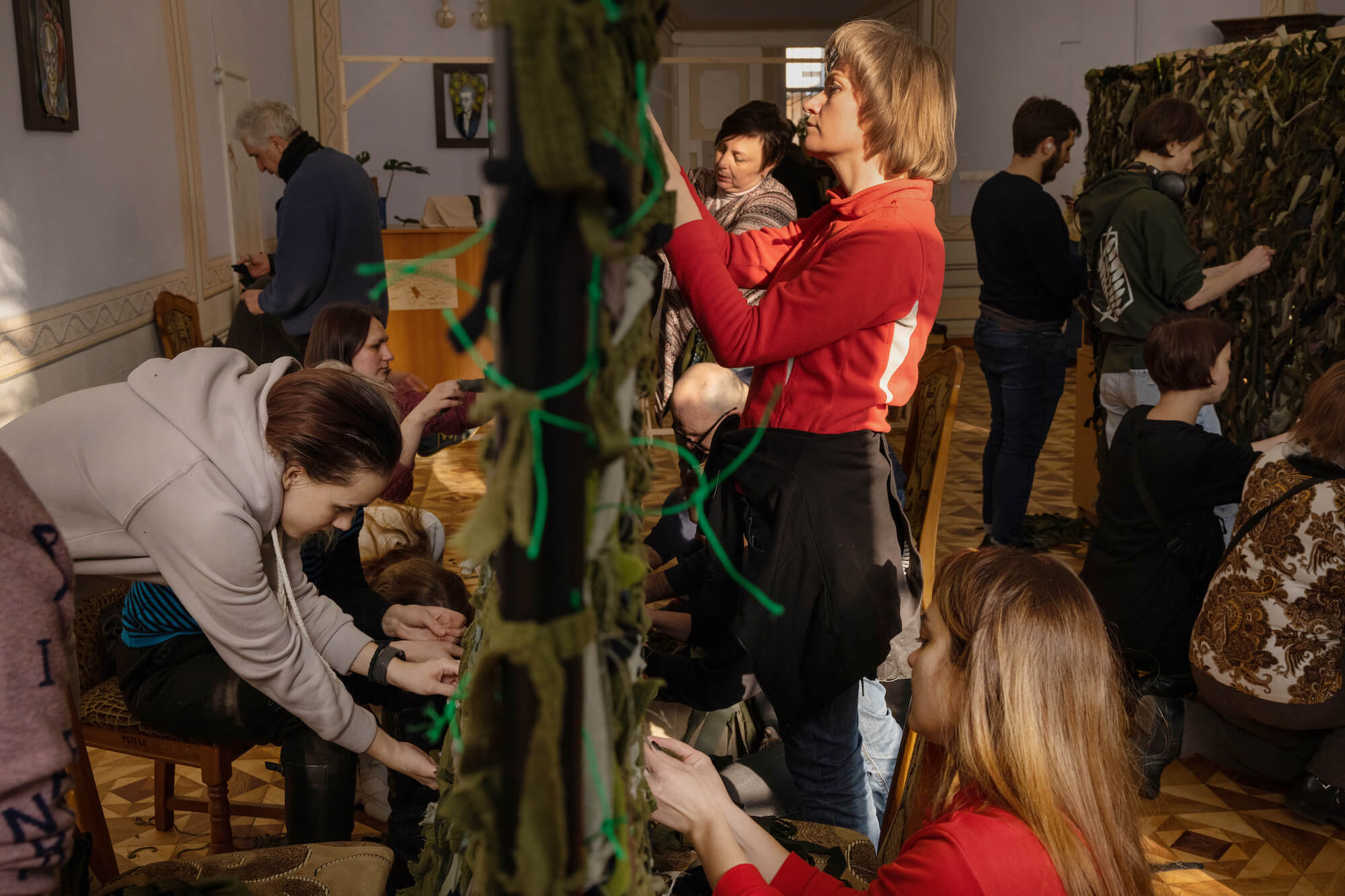
Volunteers weave camouflage nets in the Lviv library. March 2022

This apartment in Bucha is located next to a street where there was a lot of destroyed equipment. A local man and his elderly father hid there during the entire period of occupation. April 2022

A farmer in the Odesa region holds a little boy as Putin's image is shown on TV.
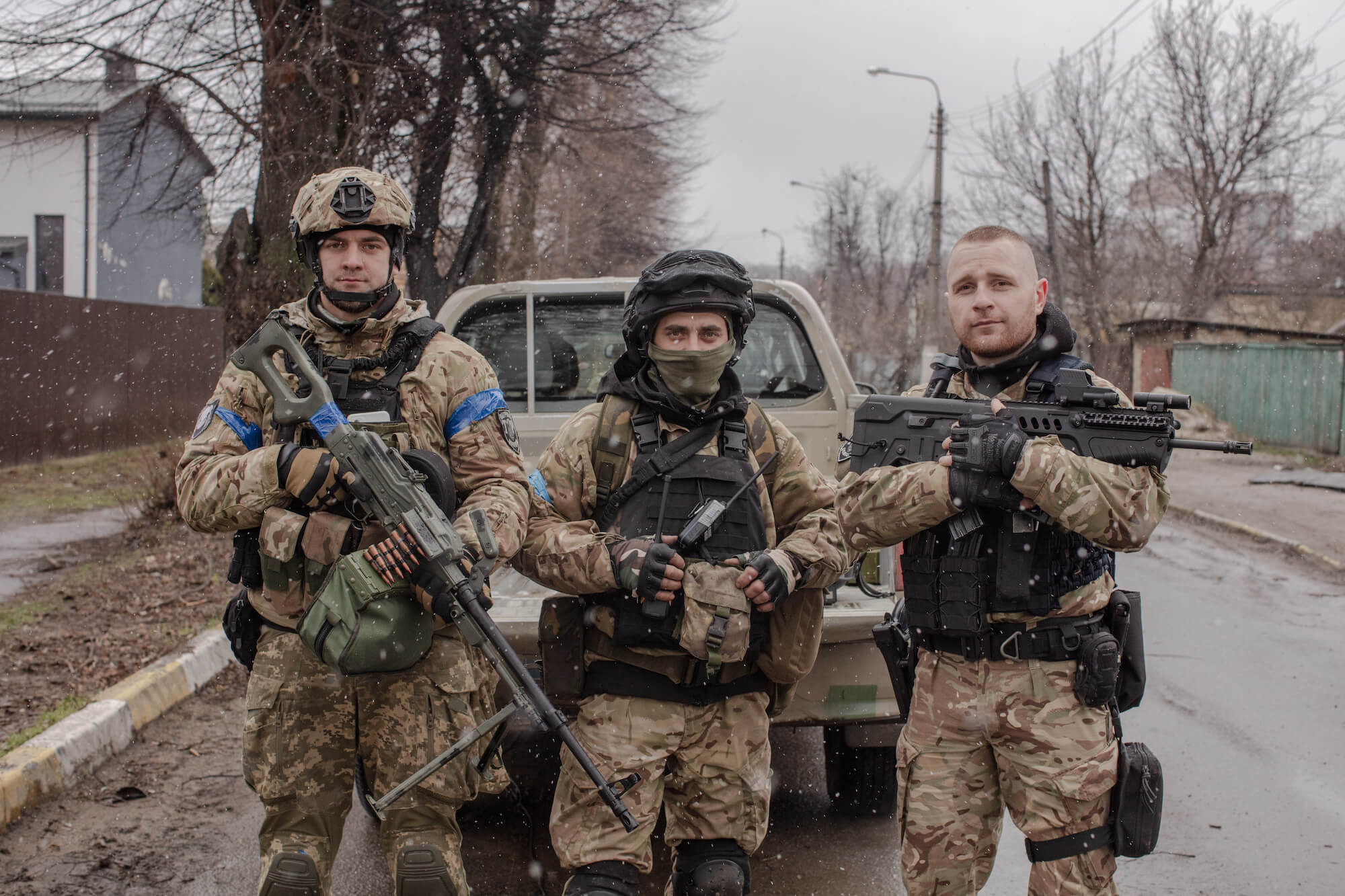
Ukrainian soldiers in Bucha shortly after the de-occupation. April 2022
What do you remember about your first days in Ukraine? What was your impression?
My first impression of Lviv was that it was so beautiful. The same was in Kyiv. Even when I heard constant artillery attacks, I could still feel the strength and energy of the city, its culture and its rebelliousness. I know that it is becoming like a cliche among foreign photographers to talk about strength, and I know that there is so much pain, suffering, and loss, layered underneath and on top of that strength. But I was amazed by how tough and down-to-business people were. They were like, let’s go, let’s volunteer, let’s fight, we’re not going to be beaten down. That energy inspired me and made me want to represent it and honor it in some way.
So you’ve been to Kyiv and Lviv. Which other cities have you been to and which one of them stands out to you the most?
I have been lucky to travel around Ukraine a lot. I was in Kharkiv, Odesa, Mykolaiv, in the Donetsk region. Kyiv really impacted me with its culture of youth and its energy, which I vibed with as a New Yorker. Kharkiv had this amazingly creative and artistic atmosphere. Odesa astonished me with its great architecture, sense of humor, and sense of roots for me. Donbas impressed me with its toughness and warmth, which people preserved during the eight years of war. Every time I got to a new place, I learned a new layer of love and respect for it.
What physical and emotional challenges did you encounter, while documenting the war?
Physically, I can’t complain. I’ve mostly been staying in comfortable hotels, or in certain moments I stayed in shelters or churches. Even if I had no electricity for days, I thought I can handle it, because Ukrainian babushkas managed to deal with power outages for months.
Emotionally, that’s a little bit more complicated. Because you have to keep your emotions under control in order to do the work properly and respectfully. On the other hand, I want my photography to have an emotional impact. And it means keeping myself open, not locking down, or going numb no matter how scary and heartbreaking the experience is. If I’m asking somebody to share the worst moments of their lives, I want to make sure that I’m fully present. As a photographer, your work requires you to be continually pushing against the edge of the most intense things. During the first couple of days of my trips to Ukraine, I would catch myself getting really tearful. But I have learned that there is a threshold — after maybe a month or six weeks — when I start to feel that I’m not present anymore. On the last days of my work in Bucha, I couldn’t touch my camera, because I felt that I had nothing more to say in terms of photography.
Was it exhaustion?
More like a knife going dull. I had to let myself heal so that I could get hurt again. It’s not about my pain, obviously, but it’s about doing justice and paying respect to others. I couldn’t be completely numbed out if I wanted to pay respect to those people in my photos.
Besides, I know that at some point, the fear goes away. I was younger when I first experienced that fearless feeling and thought that it was like a superpower. Now I realize I just turned into a moron. Out-of-control fear is a liability, but having no fear is a liability too.
And how do you find this balance?
It comes and goes. You can spend weeks and weeks looking at the worst things and not being able to contact any emotions, and then something small happens, and you are falling apart. I think that for a long time, photojournalism practiced a culture of being very tough. That’s changing now, and it’s a good thing. Of course, sometimes we all need that numbness to stay sane. But when I’m looking somebody in the eyes and saying that I’m sorry, I want them to see that I really mean it.
For a long time, photojournalism practiced a culture of being very tough. That’s changing now.

The remains of the "Mriya" airplane in Hostomel. April 2022
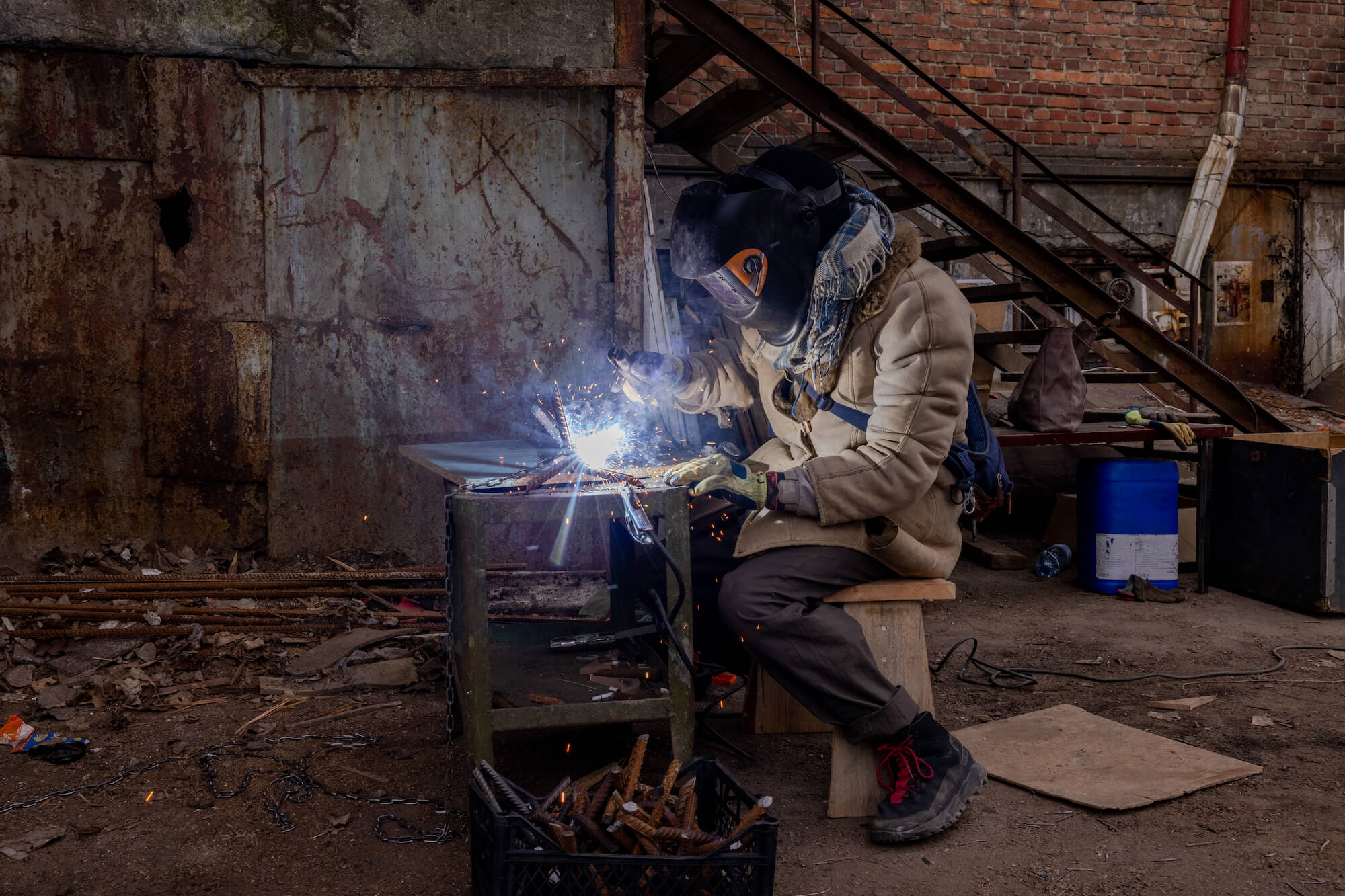
In a peaceful life, this man is an artist, but now he makes anti-tank obstacle defense in his art center. March 2022

The body of an elderly man on the roadside in Bucha. He has a white armband on his arm — these were worn by civilians during the occupation. April 2022

The mother of Ukrainian soldier Taras Didukh cries over his body at the funeral in Lviv. March 2022

A girl slides down a hill in Borodyanka. December 2022
There are so many women in your photos — mothers, farmers, and so on. Can you please tell me about those women? What were you trying to convey with their portraits?
The first time I met the Ukrainian women was when I took the train to follow mothers who were returning home to their children at the beginning of the full-scale invasion. From that moment I knew there was a particular character to Ukrainian women. They had strength, grace, and inner steel. I met a woman named Alisa, whose son was lost in Mariupol, and she couldn’t find him for two weeks. Luckily, she found him and was able to get him out of the country for safety. I met women farmers in Mykolaiv. Everything they did — drove a tractor, put on lipstick, low-key housed a battalion of soldiers — was an act of rebellion to me. There is real courage in being kind and supportive when your home is under attack.
Which story stuck with you the most?
Those stories that stuck with me are some of the hardest ones. The first thing that pops into my head, is a story of a young woman, whose mom was in the armed forces of Ukraine. We really bonded with her — she was a dancer, we were into the same music, we laughed a lot. On the third or fourth day of the full-scale invasion, she was about to go home to her family. She showed me their pictures when her phone rang: she was told that her mother was killed. It was one of the hardest things I have ever seen. It’s different from watching horrible violence, or dead bodies, or destruction after a missile attack. I simply watched the young woman’s face and saw grief and pain there. That’s when I realized what the war really was. Sometimes we get distracted by the action and forget that the consequences of that action are a loss.
Sometimes we get distracted by the action and forget that the consequences of that action are a loss.
When you do documentary photography, what’s more important to you — to capture a moment here and now or to dig deeper and learn about people’s history?
They both are important. When we are talking about something that will have historical value, my first responsibility is to capture the here and now as faithfully as I can. We have to be honest, and we have to keep learning. And if you can achieve the combination of these factors — the significance of the moment and your ability to learn — then you can make something that will last.
Can documentary photography be objective?
No, it can’t be and it’s not. We’re not objective, we’re humans. There continues to be this mythology of objectivity in some corners of journalism, but we all bring the biases of our beliefs, culture, and history into our work. If I’m documenting abortion, I’m not going to tell you that I’m not pro-abortion. If I’m documenting Black Lives Matter, I’m not going to tell you that I’m not against racism. I have a position. And I think we lose the trust of our audience when we try to pretend that we are neutral.
There is this false construction, especially in the American audience, that if you are a reliable narrator you should be presenting both sides. But who said that history is binary and that each side is equal? Ukrainian people are being invaded, their citizens are being murdered, there are no equal sides to this story. In my career, there were just a few situations that I could describe as a conflict between good and evil, and this is one of them. It’s not complicated, it’s not controversial. Russia is doing monstrous things to the Ukrainian people, and they are defending themselves, and that’s it. So my colleagues and I, we explain that there is a right and wrong here.
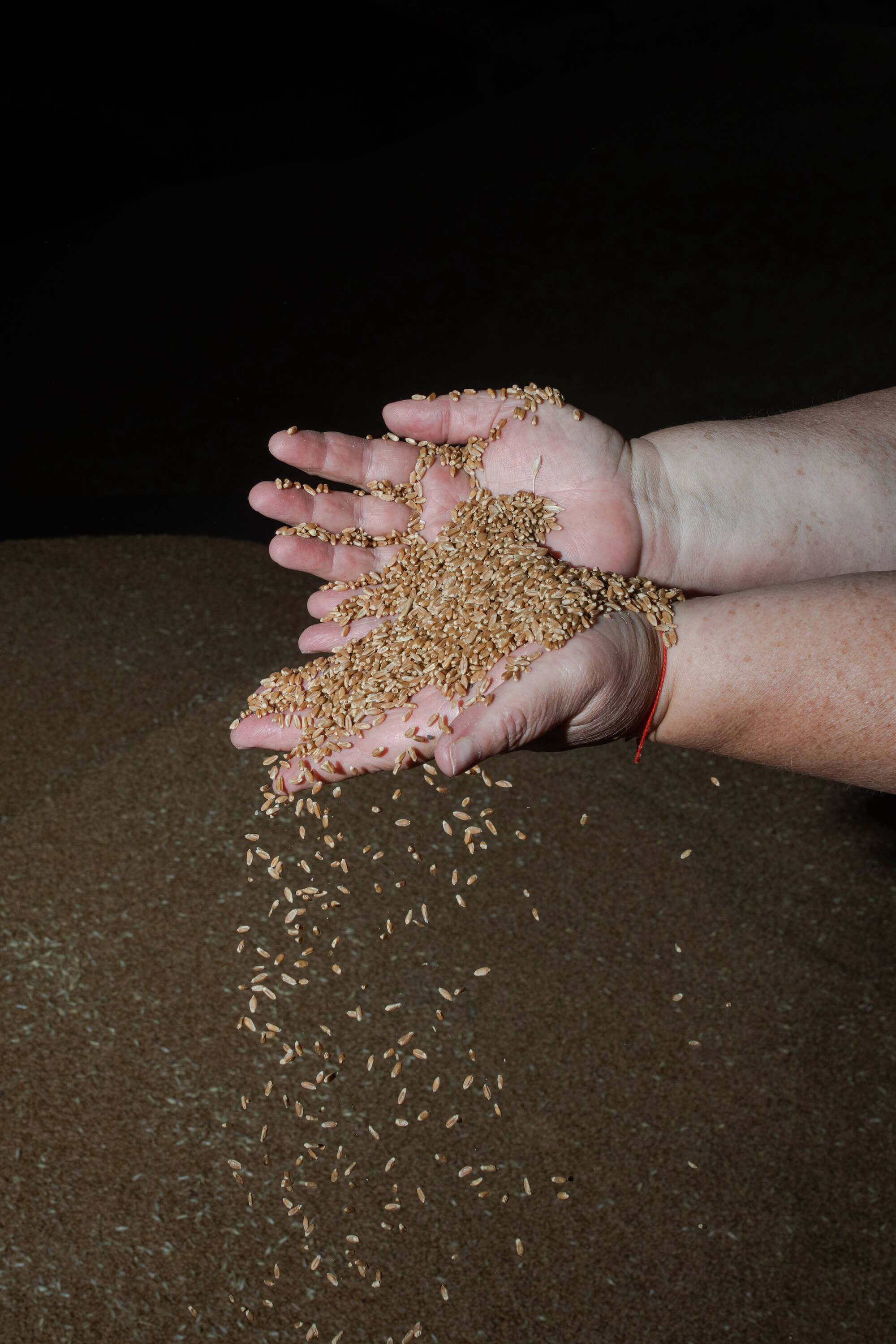
Nadiya, who runs a farm in the Mykolayiv region, shows the grain in storage. July 2022

Nadiya manages a large farming enterprise in the Mykolayiv region. She is posing in a storage building where numerous holes from projectile fragments can be seen in the ceiling and walls. The equipment is also partially damaged. July 2022

Nadiya is a farmer from the Mykolayiv region. She is posing against the background of one of her fields, the smoke on the horizon is from the Kherson side. The woman helps soldiers with food and shelter. She has to work under constant shelling and hope that the grain will be collected and sold. July 2022

Anna, 33 years old, her daughter Alya, 3 years old, her son Zhenya, 5 years old, her mother Natalya, and their dog Mike. They are in a shelter in Lviv. Before that, the family spent 12 hours on a train from Kyiv, where there were so many people that they had no place to sit down.

Natalya, who has just crossed the border with Poland, poses against the background of boxes with clothes for refugees. March 2022

Sunflower on a field in the Mykolayiv region. July 2022

Rodion Galyrov, 18, poses for a portrait on his motorcycle at the beach in a village outside Serhiivka.

Natalie, a 15-year-old girl whose mother narrowly survived a rocket attack that destroyed the family's apartment in Serhiivka, a village outside Odesa, listens as her mother discusses the walls caving in on them and miraculously stopping before she and her son were crushed.
I can’t help but ask about the photo series from the Polish-Ukrainian border, where you documented racism and discrimination from the side of Ukrainian officials. What was the idea behind that photo project? Were you considering the possibility that those photos can discredit Ukrainian officials and maybe even do harm? ?
I thought about this a lot. Back then, I got to the border and that was the first thing I worked on for Time magazine. I saw people, who were experiencing racism and discrimination as they were fleeing Ukraine and as they were entering Poland. It was a story about human rights violations, and it was important. I’m not saying it was more important than everything else, no. I just came there, saw those things, and, as a journalist, couldn’t help but report on them.
As documentary photographers, we owe people honesty. And honesty is a very different metric from objectivity. I’m not going to tell you that I don’t have a side. What I will say is that I’m not going to lie to you if my side doesn’t always look pretty. During the whole year, I covered assaults on the human rights of the Ukrainians. But I also made one story about assaults on the human rights of other people. I hope that it shows that I’m a reliable narrator and I’m not making propaganda.
As documentary photographers, we owe people honesty. And honesty is a very different metric from objectivity.
And what was the reaction to that series?
The reaction has generally been an appreciation for the need to document that situation. And it was also contextualized by the struggle of the Ukrainian people, which was the main part of the story. I don’t feel that my presentation of that work has ever been meant to compete with or overshadow anything.
You’ve mentioned propaganda, and I wanted to ask you what it is to you. Is there any difference between an actual documentary photo and manipulative propaganda?
Photography is a subjective experience, and surely documentary photos can be used for propaganda. As soon as we put a photo into the world, we lose control of it, and it becomes whatever people are bringing into it. A part of being a professional documentary photographer is having the skill to create images that are difficult to use as propaganda. It’s something that you come closer to through your body of work. It’s through a long series of documentary images that you start to show what’s important, what nuances and elements of the story you are highlighting.

Railway station in Lviv. A woman says goodbye to a soldier who is going to the east of the country. March 2022

Consequences of the explosion of a Russian missile in Odesa. July 2022
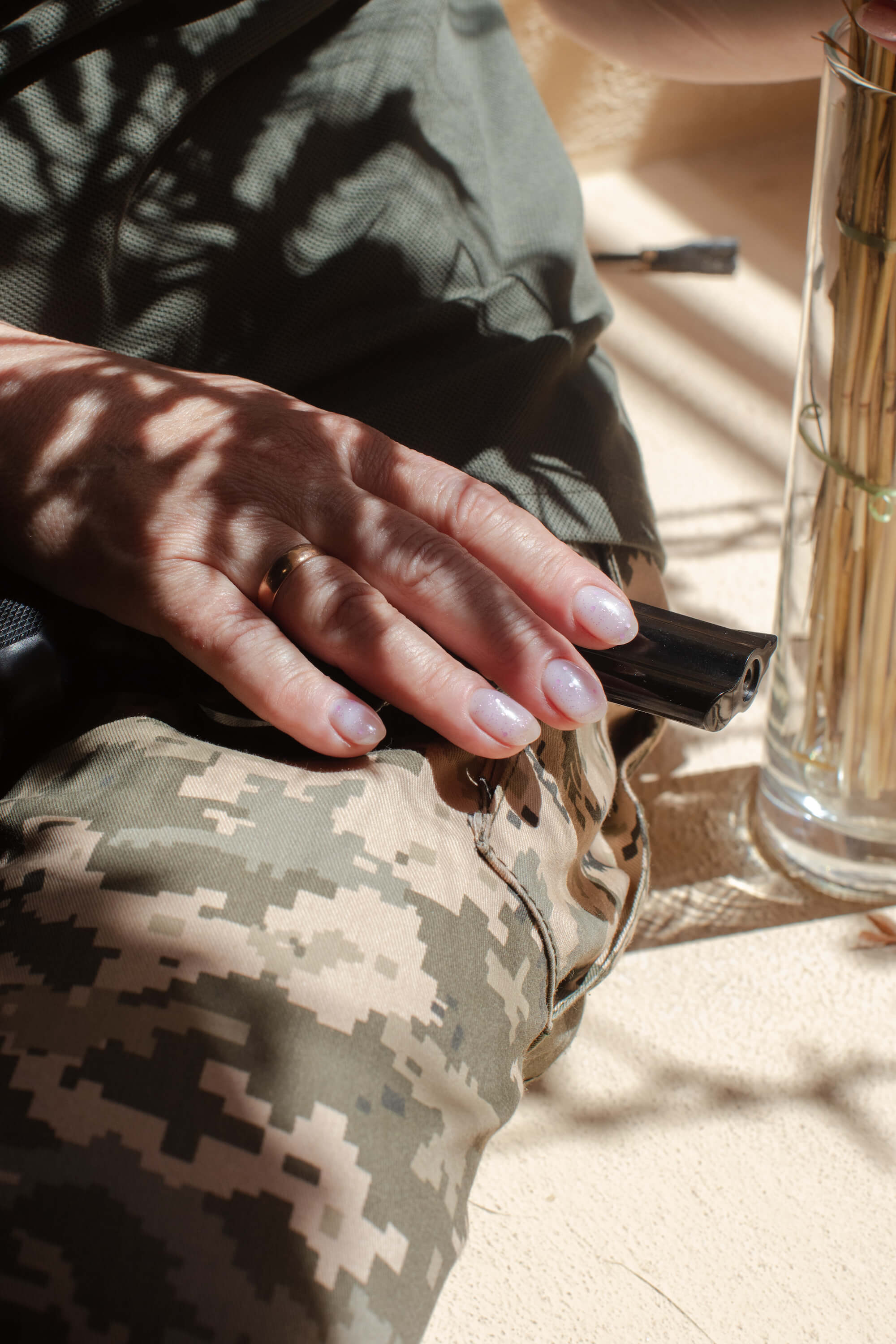
A female military chaplain poses with her pistol in her lap for a photo in Odessa while on a break for serving in July.

A mural remains intact in a destroyed school in Mykolayiv in July.

The town of Bilozirka, Mykolayiv region, was about a kilometer from the front line when the Russians shelled it. Tons of wheat and sunflowers turned into ashes. July 2022

Alisa Kosheleva in the Lviv cafe. She took a photo of her son with her. When the invasion began, Alice was on vacation for the first time in three years, but returned from Barcelona to Ukraine. Her son, along with his father and the rest of the family, stayed in Mariupol. She has been here for a week, but she still doesn't know what happened to them

Left: A building in Kyiv damaged by a rocket strike. Right: A boy in a bomb shelter in Kyiv when it was encircled by Russian forces.

Bert Willhaus from the Netherlands is waiting in Przemyśl for a train to Ukraine. He is a soldier and wants to help. Bert does not yet know where exactly he will go from Lviv
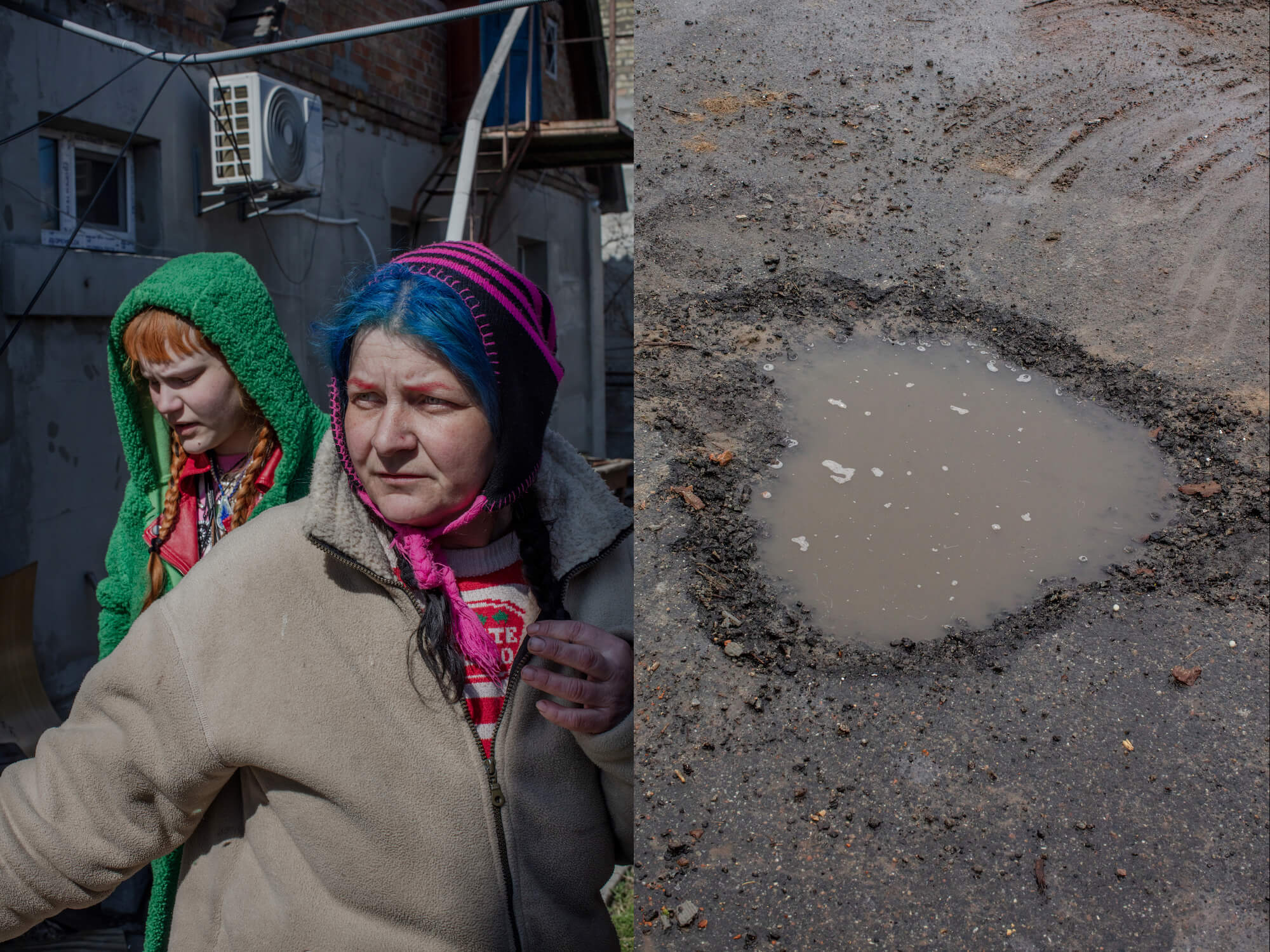
Galya and her daughter Veronika hid in their house during the entire period of occupation of Bucha. She says that Russian soldiers constantly came to them and threatened to kill them. April 2022
During this war, we see a lot of non-professional images taken with one’s phone. What do you think about this kind of documenting history?
I have no beef with that. Photography used to be much more exclusive because of the prohibitive technical requirements and the cost of the gear. The fact that it is democratizing now is very much a good thing.
What’s tricky, in the context of conflicts and trauma, is that there is a great deal of responsibility that comes with documenting situations. Being a professional means, first of all, having the training to do your job safely for yourself and others. Secondly, professional photographers understand how things are going to be visually interpreted and try to protect against accidentally releasing untrue images. What I know for myself, as a professional, is that I will not manipulate images, I will not ask people to change their behavior, I will not hide anything, although Russians may want to say that.
The most important photographs of the century may as well be taken by non-professional photographers on their cellphones. But to see the value of a professional documentary practitioner, you need to look at Yevhen Maloletka’s works. He’s been in a lot of situations that were almost too dangerous to cover. And he is also such an incredible documentarian. He is able to capture and emphasize horror, following the highest standards of journalism. The aesthetics are for sure the least important things, but his pictures really have this ability to stop the world in its tracks.
Speaking of aesthetics. Your photos are really beautiful: the scenery, the skies, the sea, and nature — it all adds up to a beautiful image. How do you balance the aesthetics and tragic context of military photography?
I feel that there is no right answer to it. On one hand, the aestheticization of war is arguably ethically wrong. It glorifies the war and makes it look sexy, taking the horror out of it when it should be amplified. And to a certain extent, that’s what I do as a photographer and an artist, and I have sleepless nights because of that. But the other side of this argument is how we get people to pay attention. I don’t like the opposite situation, when you intentionally make something look uglier than it is. That can be reductive and stereotyping to people who experience it, making the war look alien like it’s happening somewhere far away. I think by creating beauty, I bring the otherness of war much closer to us.
The aestheticization of war is arguably ethically wrong. As a photographer and an artist I have sleepless nights because of that.

Residents of Bucha meet the Ukrainian military and volunteers. People are still in shock after what they experienced during the occupation. April 1, 2022

The funeral of three Ukrainian soldiers in the Garrison Church of the Holy Apostles Peter and Paul in Lviv. March 2022

Smoke after a missile strike in Odesa. July 2022

An anti-tank hedgehog on a field in the Odesa region. July 2022
You see the war as a foreign photographer. What are the ups and downs of having this outsider’s view?
Firstly, I should say that all Ukrainian photographers are doing this better than me. Anyone who is looking at my work, I’m grateful to you, but you should go look at the works of the Ukrainian photographers. That said, I think that when you come as an outsider, you do see things from a different perspective. For example, you might notice those things, which became so ordinary and mundane for the Ukrainians that they barely pay attention to them. I would never be able to tell you something about this war in such detail that a Ukrainian photographer can, but maybe I will be able to translate it for other Americans.
And do you think you can change something in their attitude? Does documentary photography have the power to change people’s minds?
I’m tortured by this question. I’m often very skeptical. I think that maybe once a year or once in a generation there might be a photo that can transcend to be a vehicle for change. Probably, in the days of analog photography and physical print media, it was easier to take such a picture. But still, it’s hard to know whether those images were a catalyst of change or symbol of change. I guess there is a lot of ego in thinking: I’m going to make a picture that will change the world. But I do believe that our work can apply pressure. So I will keep saying: look over there, pay attention to this, it’s important.
There is a lot of ego in thinking: I’m going to make a picture that will change the world.
Besides, the best part of my job is the interactions with people. I can’t change the world, but at least this work is changing me. When I publish my images, thousands of people see these stories, someone makes donations. And I do believe in those small personal changes.
How do you see your role as a photographer in this war?
It is a simple but also aspirational mission of making people pay attention. And not just pay attention and shake their heads, but genuinely care, donate or urge their politicians to support Ukraine. On a personal level, I’m also trying to understand how the fuck in 2023 we are still letting this happen. I do think that we, as a society, could stop this and the fact that it had not been done is a colossal failure. Somewhere in my practice, I’m looking to make that critique.
New and best








